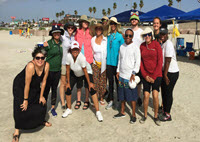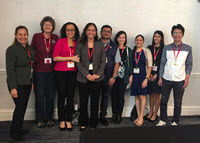
Deepwater Horizon oil impacted over 1,700 km of Gulf of Mexico coastline and prompted 89 beach closures, largely due to uncertainty about health risks associated with oil contamination. Compared to adults, children spend more time in the sand when at the beach and touch their face more often, increasing potential exposure to contaminants through skin contact or ingestion. Tanu Altomare analyzed data quantifying children’s beach behaviors to inform a model evaluating health risks to young children when playing on oil-contaminated beaches. Responders can use the model’s assessments when making decisions about beach closures and communicating risks to the public when future pollutant events happen.
Tanu was a Ph.D. student with the University of Texas Health Science Center at Houston’s School of Public Health and a GoMRI Scholar with the project Beach Exposure And Child HEalth Study (BEACHES).
Her Path

When Tanu was a microbiology student at the University of Houston-Downtown, a guest lecturer discussed environmental risk assessments of pollutants in or near residential homes. Tanu had been conducting laboratory experiments but wondered if the long stretches without human interaction were right for her. By contrast, the lecturer’s work that combined environmental science, epidemiology, and social and behavioral science fascinated her.
While researching graduate schools, Tanu toured the School of Public Health at the University of Texas Health Science Center at Houston and subsequently accepted a graduate research position toward a Master of Public Health. She worked closely with Dr. Kristina Mena investigating the factors influencing microbial load (the number and type of microorganisms contaminating a water body) in two Galveston Bay marinas and hoped to complete a doctorate under her mentorship. Tanu described her research interests to Dr. Mena, who recommended the GoMRI-funded BEACHES project exploring how interactions between people’s behavior and the environment influence their health – concepts that first got Tanu interested in public health.
“I’ve lived in Houston for nearly 20 years, and I’ve been present for a variety of natural and man-made disasters, including Hurricane Harvey and the Deepwater Horizon spill,” said Tanu. “I’ve seen firsthand how those events affected my community, so I’ve always had a personal stake in better understanding the effects of disaster and behavior on health and wellbeing.”
Her Work

The BEACHES team is developing an assessment platform that will provide health risk information on children playing at oil-contaminated beaches. The model currently uses benchmarks established in the Environmental Protection Agency (EPA) Exposure Factors Handbook to determine health risk, but real-time data will help refine these benchmarks so that they are applicable to children of different ages, genders, and demographics. Tanu and her fellow BEACHES researchers video recorded children (with guardian permission) playing in Florida and Texas beach sands over a ten-day period. The team monitored behaviors that would affect children’s exposure risks, especially how often they touched their mouths, the frequency and length of time they spent in water and sand, and how much sand stuck to their hands and bodies when their skin was wet, dry, or had sunscreen on it.
Tanu analyzed the video data using a risk assessment software called Crystal Ball, which returns a best-case, worst-case, and most likely outcome for a scenario. Her preliminary analyses suggest that exposure frequency (how many days per year children go to the beach) had the greatest influence on health risk estimates out of the factors analyzed so far. This observation supports the expectation that factors with a wide range of variability like exposure frequency will influence risk estimates more strongly than variables like body weight or skin surface area, which show little fluctuation among children. However, she is eager to see how estimates change once data on soil intake rate (oral exposure), adherence factor (skin exposure), and inhalation rate are incorporated into the model.
“I think this model will be especially useful for agencies involved in communicating advisories and other health information to the public. Instead of blanket advisories, they can provide a more thorough explanation of how and why the public should or should not avoid certain beach-related activities following a disaster event,” said Tanu. “For example, [the observations about exposure frequency] can be valuable for families living in Gulf communities, because they tend to visit beaches more often than families who only go once or twice a year.”
Her Learning
Working with an interdisciplinary group showed Tanu how real-world science unfolds, with researchers relying on each other to fill in different pieces of a larger puzzle. A memorable moment for Tanu was hearing Dr. Alesia Ferguson’s observations about their video recordings, who commented that children behaved differently depending on if their mother, father, or siblings were present and that there were behavioral trends for children of different racial backgrounds. “At that moment, the multitude of factors that play into how a person interacts with their environment really hit home,” said Tanu. “Sometimes, I get narrowly focused on the scientific parts of the equations, like the chemical concentrations, but there is a human factor that has a profound effect on health outcomes.”
As a member of the GoMRI community, Tanu interacted with an extensive network of researchers, policymakers, and industry leaders. When she began her doctoral research, Tanu anticipated that her advisor would be her main mentoring resource, but she also received feedback from many GoMRI community members. She attended a graduate student luncheon at the 2020 Gulf of Mexico Oil Spill and Ecosystem Science Conference, where she engaged with fellow students and experts from diverse fields. “The leaders of GoMRI have taught me a lot of what it means to be a researcher and collaborator,” she said. “The most important piece of advice I received at the luncheon was to always be open to new projects and opportunities, because it opens up so many new avenues for research and networking.”
Tanu also learned the importance of talking with her advisor about the future, even when she wasn’t sure what she wanted to do. “A lot of students know they want to pursue a career in science but don’t know all their options, and that can be frustrating,” she said. “I had a vague, almost incoherent idea what I was interested in, but Dr. Mena helped me form a concrete idea. She took my interests and connected it to an awesome project!”
Tanu completed her Public Health doctorate and is seeking opportunities where she can continue working with the marine environment and children’s health.
Praise for Tanu
Dr. Mena described Tanu as an engaging student and a forward-thinking researcher, who asks the right questions about things that others may overlook. “Tanu was an integral part of the field work for this study as well as the risk assessment component,” she said. “She was not only a remarkable student, but she is also an exceptional person. I look forward to hearing about her future contributions.”
The GoMRI community embraces bright and dedicated students like Tanu Altomare and their important contributions. The GoMRI Scholars Program recognizes graduate students whose work focuses on GoMRI-funded projects and builds community for the next generation of ocean science professionals.
By Stephanie Ellis and Nilde Maggie Dannreuther. Contact sellis@ngi.msstate.edu for questions or comments.
************
The Gulf of Mexico Research Initiative (GoMRI) is a 10-year independent research program established to study the effect, and the potential associated impact, of hydrocarbon releases on the environment and public health, as well as to develop improved spill mitigation, oil detection, characterization and remediation technologies. An independent and academic 20-member Research Board makes the funding and research direction decisions to ensure the intellectual quality, effectiveness and academic independence of the GoMRI research. All research data, findings and publications will be made publicly available. The program was established through a $500 million financial commitment from BP. For more information, visit http://gulfresearchinitiative.org/.
© Copyright 2010-2020 Gulf of Mexico Research Initiative (GoMRI) – All Rights Reserved. Redistribution is encouraged with acknowledgement to the Gulf of Mexico Research Initiative (GoMRI). Please credit images and/or videos as done in each article. Questions? Contact web-content editor Nilde “Maggie” Dannreuther, Northern Gulf Institute, Mississippi State University (maggied@ngi.msstate.edu).
